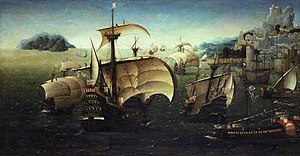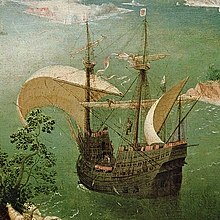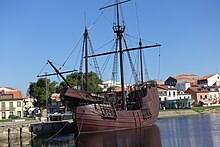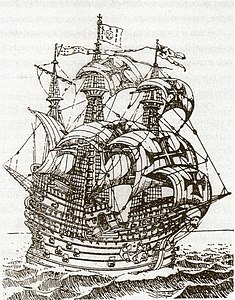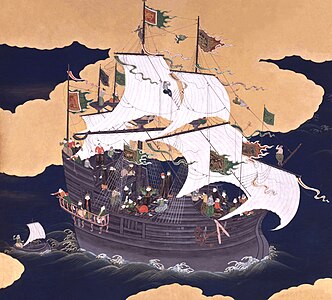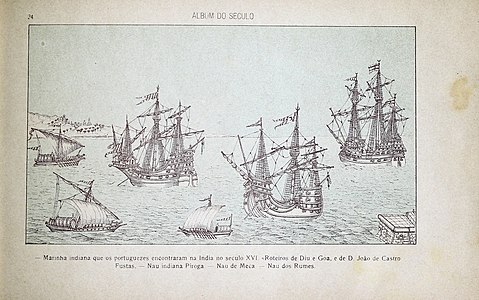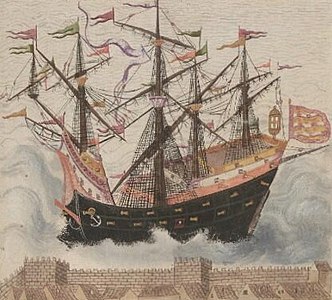
A sailing ship is a sea-going vessel that uses sails mounted on masts to harness the power of wind and propel the vessel. There is a variety of sail plans that propel sailing ships, employing square-rigged or fore-and-aft sails. Some ships carry square sails on each mast—the brig and full-rigged ship, said to be "ship-rigged" when there are three or more masts. Others carry only fore-and-aft sails on each mast, for instance some schooners. Still others employ a combination of square and fore-and-aft sails, including the barque, barquentine, and brigantine.

A sailing vessel's rig is its arrangement of masts, sails and rigging. Examples include a schooner rig, cutter rig, junk rig, etc. A rig may be broadly categorized as "fore-and-aft", "square", or a combination of both. Within the fore-and-aft category there is a variety of triangular and quadrilateral sail shapes. Spars or battens may be used to help shape a given kind of sail. Each rig may be described with a sail plan—formally, a drawing of a vessel, viewed from the side.

A brigantine is a two-masted sailing vessel with a fully square-rigged foremast and at least two sails on the main mast: a square topsail and a gaff sail mainsail. The main mast is the second and taller of the two masts.

Galleons were large, multi-decked sailing ships developed in Portugal and Spain and first used as armed cargo carriers by Europeans from the 16th to 18th centuries during the age of sail and were the principal vessels drafted for use as warships until the Anglo-Dutch Wars of the mid-1600s. Galleons generally carried three or more masts with a lateen fore-and-aft rig on the rear masts, were carvel built with a prominent squared off raised stern, and used square-rigged sail plans on their fore-mast and main-masts.

The caravel is a small maneuverable sailing ship used in the 15th century by the Portuguese to explore along the West African coast and into the Atlantic Ocean and by Columbus on his expeditions of exploration of the Americas. They used both lateen and square sails and were known for their agility and speed and their capacity for sailing windward (beating) with their lateen sails. Caravels were used by the Portuguese and Spanish for the voyages of exploration during the 15th and 16th centuries, in the Age of Discovery.

Carvel built or carvel planking is a method of boat building in which hull planks are laid edge to edge and fastened to a robust frame, thereby forming a smooth surface. Traditionally the planks are neither attached to, nor slotted into, each other, having only a caulking sealant between the planks to keep water out. Modern carvel builders may attach the planks to each other with glues and fixings. It is a "frame first" method of hull construction, where the shape is determined by the framework onto which the planks are fixed. This is in contrast to "plank first" or "shell first" methods, where the outer skin of the hull is made and then reinforced by the insertion of timbers that are fitted to that shape. The most common modern "plank first" method is clinker construction; in the classical period "plank first" involved joining the edges of planks with mortise and tenon joints within the thickness of the timbers, superficially giving the smooth-hull appearance of carvel construction, but achieved by entirely different means.
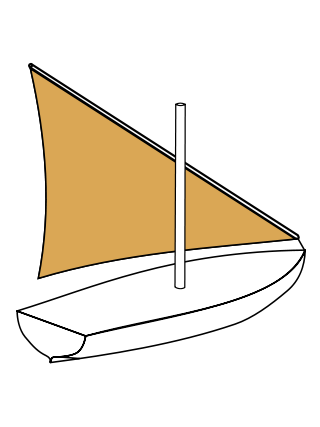
A lateen or latin-rig is a triangular sail set on a long yard mounted at an angle on the mast, and running in a fore-and-aft direction. The settee can be considered to be an associated type of the same overall category of sail.

The mast of a sailing vessel is a tall spar, or arrangement of spars, erected more or less vertically on the centre-line of a ship or boat. Its purposes include carrying sails, spars, and derricks, giving necessary height to a navigation light, look-out position, signal yard, control position, radio aerial or signal lamp. Large ships have several masts, with the size and configuration depending on the style of ship. Nearly all sailing masts are guyed.

A fluyt is a Dutch type of sailing vessel originally designed by the shipwrights of Hoorn as a dedicated cargo vessel. Originating in the Dutch Republic in the 16th century, the vessel was designed to facilitate transoceanic delivery with the maximum of space and crew efficiency. Unlike rivals, it was not built for conversion in wartime to a warship, so it was cheaper to build and carried twice the cargo, and could be handled by a smaller crew. Construction by specialized shipyards using new tools made it half the cost of rival ships. These factors combined to sharply lower the cost of transportation for Dutch merchants, giving them a major competitive advantage. The fluyt was a significant factor in the 17th-century rise of the Dutch seaborne empire. In 1670 the Dutch merchant marine totalled 568,000 tons of shipping—about half the European total.
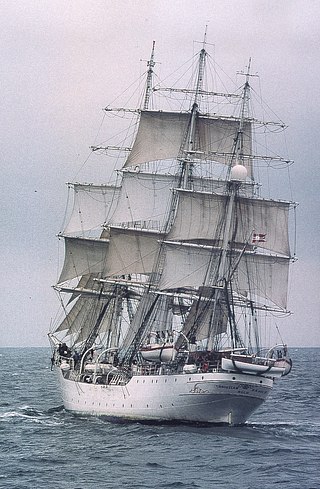
A full-rigged ship or fully rigged ship is a sailing vessel with a sail plan of three or more masts, all of them square-rigged. Such a vessel is said to have a ship rig or be ship-rigged, with each mast stepped in three segments: lower, top, and topgallant.

A fore-and-aft rig is a sailing vessel rig with sails set mainly along the line of the keel, rather than perpendicular to it as on a square rigged vessel.
Medieval ships were the vessels used in Europe during the Middle Ages. Like ships from antiquity, they were moved by sails, oars, or a combination of the two. There was a large variety, mostly based on much older, conservative designs. Although wider and more frequent communications within Europe meant exposure to a variety of improvements, experimental failures were costly and rarely attempted. Ships in the north were influenced by Viking vessels, while those in the south by classical or Roman vessels. However, there was technological change. The different traditions used different construction methods; clinker in the north, carvel in the south. By the end of the period, carvel construction would come to dominate the building of large ships. The period would also see a shift from the steering oar or side rudder to the stern rudder and the development from single-masted to multi-masted ships. As the area is connected by water, people in the Mediterranean built different kinds of ships to accommodate different sea levels and climates. Within the Mediterranean area during the Medieval times ships were used for a multitude of reasons, like war, trade, and exploration.
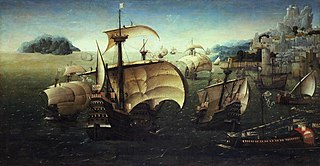
The Portuguese Indian Armadas were the fleets of ships funded by the Crown of Portugal, and dispatched on an annual basis from Portugal to India. The principal destination was Goa, and previously Cochin. These armadas undertook the Carreira da Índia from Portugal, following the maritime discovery of the Cape route, to the Indian subcontinent by Vasco da Gama in 1497–99.

Due to centuries of constant conflict, warfare and daily life in the Iberian Peninsula were interlinked. Small, lightly equipped armies were maintained at all times. The near-constant state of war resulted in a need for maritime experience, ship technology, power, and organization. This led the Crowns of Aragon, Portugal, and later Castile, to put their efforts into the sea.

The square-rigged caravel, was a sailing ship created by the Portuguese in the second half of the fifteenth century. A much larger version of the caravel, its use was most notorious beginning in the end of that century. The square-rigged caravel held a notable role in the Portuguese expansion during the Age of Discovery, especially in the first half of the sixteenth century, for its exceptional maneuverability and combat capabilities. This ship was also sometimes adopted by other European powers. Its hull resembled the shape of the later galleon and some scholars have claimed that this vessel is a forerunner of the fighting galleon, by the name of caravela de armada.

A sail is a tensile structure, which is made from fabric or other membrane materials, that uses wind power to propel sailing craft, including sailing ships, sailboats, windsurfers, ice boats, and even sail-powered land vehicles. Sails may be made from a combination of woven materials—including canvas or polyester cloth, laminated membranes or bonded filaments, usually in a three- or four-sided shape.

Maritime travel experienced a large leap in the capabilities of seafaring vessels thanks to technological improvements in shipbuilding in the early modern era. Europe, Asia, and the Middle East all saw improvements on prior construction techniques, contributing to the Age of Discovery. As a result, the introduction of these technologies in the production of naval vessels was critical as they allowed nations that utilized these advancements to ascend to a state that could expand its influence at a far greater range. In military engagements, the exploration of new lands and potential colonies, or the transportation of goods for trade, better shipbuilding techniques coincided with prosperity. It is during this time that the practice of naval architecture appeared, as skilled designers could produce designs that had an enormous impact in ship performance and capabilities.
Portuguese nautical science evolved from the successive expeditions and experience of the Portuguese pilots. It led to a fairly rapid evolution, creating an elite of astronomers, navigators, mathematicians and cartographers. Among them stood Pedro Nunes with studies on how to determine latitude by the stars, and João de Castro, who made important observations of magnetic declination over the entire route around Africa.
